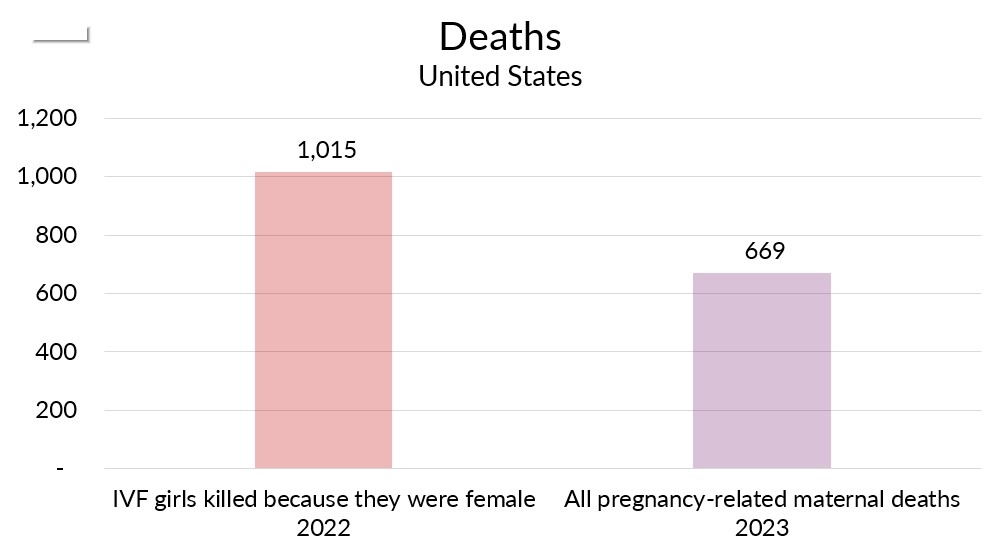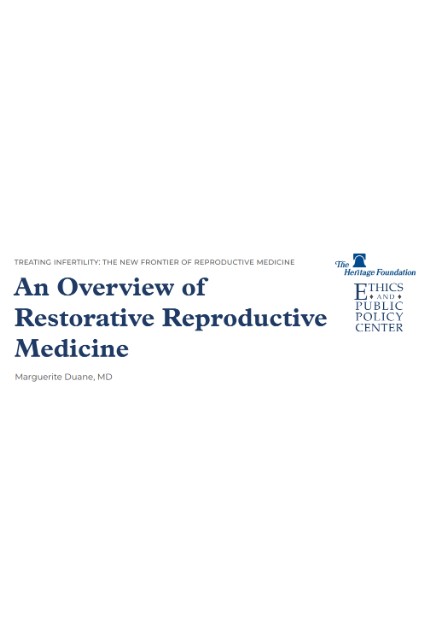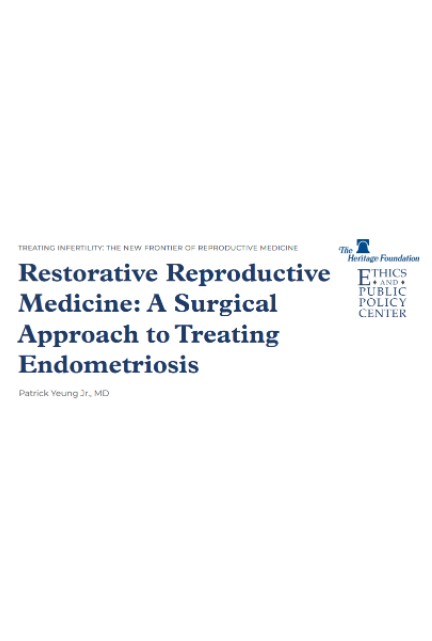Page Summary
- IVF with Prenatal Genetic Testing (PGT) results in the killing or freezing of over 1,000 girls each year, because they are female.
- This method of IVF seeks to manufacture an ideal “product” that meets the preferences of the consumer.
- Married couples who struggle with fertility should be given the hope of starting a family, but not if it means treating people like property, which is what IVF does.
Is it acceptable to use IVF to have children?
No. IVF and related methods that separate the unitive and procreative purposes of the conjugal act are incompatible with love, and those methods that entail the destruction or permanent freezing of embryos disregard the value of human life.
(Part 2)
Ok, but what does that actually mean?
Listen to this article
One particularly insidious component of IVF, though optional, is increasingly common. Through IVF with genetic testing, over 1,000 girls are intentionally killed or frozen each year *because they are female*. This is significantly higher than the number of women who die for any pregnancy-related reason.

In almost half of all IVF cycles or more, the fertilized embryos (i.e. living human beings) are screened for desirable genetic traits, including biological sex. This method of testing (PGT) selects the embryo with the most desirable traits to be gestated and born, while the others are typically discarded (i.e. intentionally killed) or, less commonly, frozen indefinitely.
In 2022, the CDC recorded a total of 98,289 live-born infants through IVF.1 Of those, at least 44,132 involved screening with PGT.2

If those infants had been born normally, we would expect there to be 22,596 boys and 21,536 girls, based on a natural sex ratio at birth of 105 males to 100 females. But this procedure doesn’t equal the natural sex ratio. The PGT sex ratio is 115 males to 100 females, meaning that female embryos are discarded at a disproportionately high rate, because they are female.3 That means that the PGT infants who were allowed to be born were actually 23,611 boys and 20,521 girls.
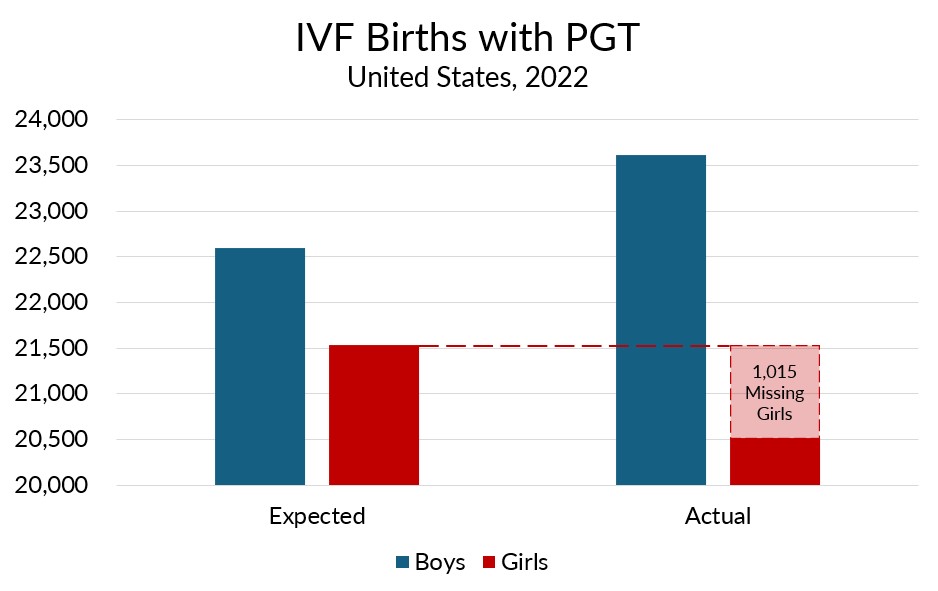
The risk of girls being killed or frozen because they are female is 89 times higher than the risk of mothers dying during pregnancy.
IVF is a more common and more deliberate cause of death than pregnancy. If the goal is to prevent the deaths of women and girls, banning IVF is a good place to start.
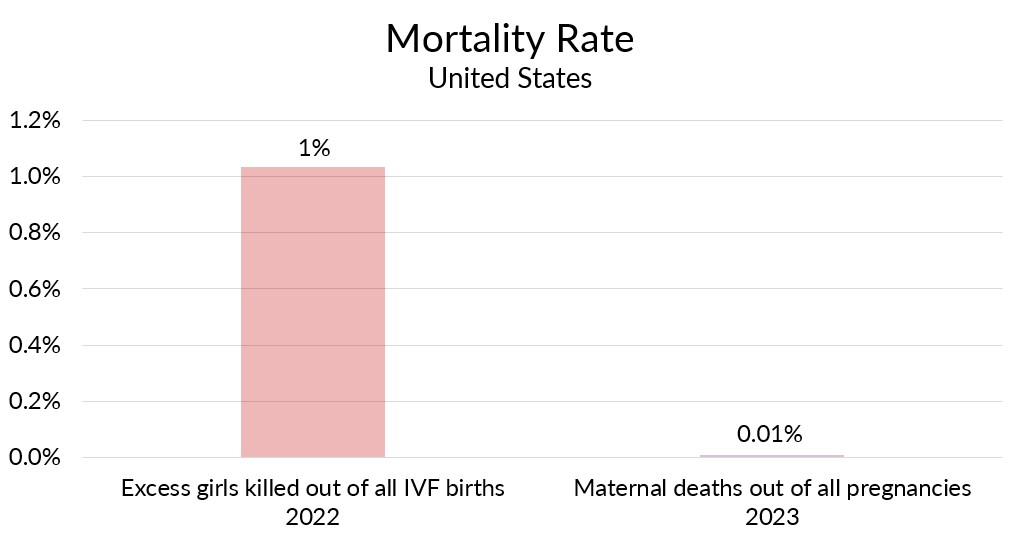
Instead of trying to remedy infertility, this approach to IVF seeks to manufacture an ideal “product” that suits the preferences of the consumer. It can’t even succeed on its own merits, because there are always unforeseen tradeoffs when breeding for genetic traits. Even if it does succeed, the approach treats each rejected embryo like an injured racehorse that is killed instead of cared for.
The approach also treats each born child like her existence depends on whether she measures up to certain “ideal” qualities. If the parents selected her because her genetic test results indicated a higher IQ, then she would be expected to perform well academically or else her birth could be deemed a “mistake”. Eugenic goals can become the standard by which her entire life is measured. When embryos are screened for preference, the parents’ love may even appear to be conditional on those preferences. If parents don’t love their sons and daughters unconditionally, they do violence to their children’s development.

The throw-away culture says, ‘I use you insofar as I need you. When I am not interested in you any more, or you are in my way, I throw you out’. It is especially the weakest who are treated this way: unborn children, the elderly, the needy and the disadvantaged. But people are never to be thrown out; the disadvantaged cannot be thrown away! Every person is a sacred gift, each person is a unique gift, no matter what their age or condition.
Pope Francis, Angelus address of January 29, 2023
A novel use of IVF also allows the return of an ancient tendency among society’s elites: polygyny. For those who can easily afford the procedure, IVF allows biological parenthood to be mass-produced. For example, an uber-wealthy father could pay to inseminate dozens or hundreds of different mothers, seeing it more as an investment opportunity rather than a loving relationship.
It might seem like science fiction, but IVF can benefit those who have the wealth and desire to reshape the real world into their preferred dystopia. Unlike the better intentions of Isabella and James in the previous page, this is a desire for individual legacy, to create as much of the world as possible in one’s own image.

Let the reader understand.
We shouldn’t be fooled by the new method, because the tendency is as old as recorded history: the libido dominandi (“lust of domination”).

…we must speak also of the earthly city, which, though the people serve it, is itself dominated by its lust of domination.
St. Augustine, The City of God, Preface
Though declining fertility is a problem at the societal level, IVF is not the solution. It makes children into tools to serve their parents’ libido dominandi, whether the parents realize it or not.
Aside from IVF, other “Assisted Reproductive Technologies” (ARTs) also seek to conceive children through novel means, all of which are retro-engineered from the natural process of procreation. Any ART that separates the unitive meaning of conjugal love from the procreative meaning is just as immoral as IVF. Any ART that treats a fertilized embryo like a commercial product that can be deliberately killed, suspended at an early level of development, sold, or replicated should be avoided, just as IVF should be.

‘Look on my Works, ye Mighty, and despair!’ Nothing beside remains.
–Percy Bysshe Shelley, “Ozymandias”
Yes, but not by any means necessary. Not if it means treating people like property. One option that avoids this problem is an approach to medicine and holistic fertility care that is sometimes called Restorative Reproductive Medicine (or RRM). Within this approach, there are at least three distinct medical models: NaProTECHNOLOGY® (often called “NaPro”), FEMM, or NeoFertility. These approaches aim at addressing any underlying medical problems, such as endometriosis. RRM can restore couples’ natural capacities for having children rather than attempting to fabricate them in a lab. RRM has also been shown to be more effective and less expensive than IVF.6,7
Couples and children alike deserve better than IVF.
1) “In 2022, there were 435,426 ART cycles performed on 251,542 unique patients at 457 reporting U.S. clinics. Their cycles resulted in 94,039 live-birth deliveries and 98,289 live-born infants.” https://www.cdc.gov/art/php/surveillance/index.html, accessed April 2, 2025.
2) “In the United States, the proportion of IVF cycles that use preimplantation genetic testing (PGT) increased from 4.5% in 2011 to 44.9% in 2018.” https://pmc.ncbi.nlm.nih.gov/articles/PMC10504547/, accessed April 2, 2025. Assuming the 44.9% PGT rate did not increase further after 2018, 44.9% of the 2022 total of 98,289 IVF births would result in 44,132 births involving PGT.
3) “Among liveborn neonates, the male/female sex ratio was higher for IVF cycles with preimplantation genetic testing for any indication (115 [males per 100 females]) than for those without preimplantation genetic testing (105), and the use of preimplantation genetic testing specifically for elective sex selection had a substantially higher (164) male/female sex ratio than preimplantation genetic testing for other indications (112).” https://pubmed.ncbi.nlm.nih.gov/35271533/, accessed April 2, 2025.
4) “In 2023, 669 women died of maternal causes in the United States, compared with 817 in 2022.” https://www.cdc.gov/nchs/data/hestat/maternal-mortality/2023/maternal-mortality-rates-2023.htm, accessed April 2, 2025.
5) “In 2023, 3,596,017 births were registered in the United States.” https://www.cdc.gov/nchs/products/databriefs/db507.htm, accessed April 2, 2025. Total number of pregnancies estimated on the assumption that 62% of pregnancies end in live birth (https://www.cdc.gov/nchs/pressroom/99facts/pregrate.htm). The 2023 total of 3,596,017 live births would be 62% of 5,800,027 pregnancies.
6) “For those 38–40 years old with 2 failed IVF attempts, a live birth rate of 17.5% was found after an additional IVF cycle, while these percentages dropped further to 9.5 and 3.6% for patients of respectively 41–42 and 43+ years old. With RRM, 38–40 year old women demonstrated adjusted life birth rates of 28.1% (crude 14.8%), while this percentage remained high in patients over 40 with an adjusted rate of 27.0% (crude 16.0).” Boyle, Phil C., de Groot, Theun, Andralojc, Karolina M., Parnell, Tracey A. (2018), Healthy Singleton Pregnancies From Restorative Reproductive Medicine (RRM) After Failed IVF. Frontiers in Medicine, 5, https://www.frontiersin.org/journals/medicine/articles/10.3389/fmed.2018.00210 (accessed June 5, 2025).
7) Katz, Patricia, et al. (2011), Costs of Infertility Treatment: Results from an 18-month Prospective Cohort Study. Fertility and Sterility 95(3), https://pubmed.ncbi.nlm.nih.gov/21130988/ (accessed June 5, 2025).



